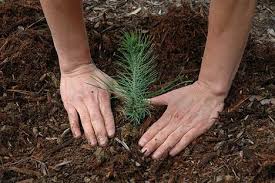We can address the pandemic while deterring climate change
March 19, 2020

Allan Cooper
OPINION by ALLAN COOPER
Catastrophic events involving profound threats to our livelihoods, to our environment and to our health are converging into a perfect storm. More than ever, we now depend on our essential service providers – our health workers, our utility workers, our police – to continue working while many of us shelter in place.
But during this pandemic, those who find themselves suddenly under- or unemployed need not despair. There are other badly needed essential services that those job-seekers can provide without forcing them to congregate. The government could create telecommuting jobs focused on badly needed public works projects. The government could also incentivize job seekers to do physical work – work done outdoors and in isolation – that could be one of the most inexpensive and effective methods in combating both pandemics and climate change.
Nearly 80 million jobs in the U.S. economy are at high or moderate risk today, according to Moody’s Analytics. That’s more than half of the 153 million jobs in the economy overall. To address this problem we need a new Work Projects Administration perhaps similar to the Green New Deal employing millions of job-seekers to carry out public works projects.
These projects could help pave the way out of our current financial crisis. These projects would include the construction and repair of our poorly deteriorating infrastructure. These projects would pair labor programs with measures to combat the climate crisis. Through state-sponsored jobs, this new deal would address poverty by focusing improvements on our more vulnerable communities.
In addition to building energy-efficient, distributed, and ‘smart’ power grids, and working to ensure affordable access to electricity, this new deal should pay unemployed job seekers a living wage for planting billions of trees. These trees should be planted in places that used to be forests using native species.
Instead of mandating the unemployed to shelter in place over the next 18 to 24 months, why not fan the able bodied out over the countryside planting trees in predesignated locations. These paid jobs could be done with minimal human interaction and would be a means toward overcoming cabin fever while getting badly needed exercise.
Of course we all understand why we would address massive unemployment by undertaking projects that would include the construction and repair of our poorly deteriorating infrastructure. But why plant more trees?
Around 2.2 billion acres of land is suitable for reforestation, according to a study in the Journal Science. That could capture two-thirds of human-made carbon emissions and, according to authors of the study, would be the most effective method of combating climate change.
Nearly half of the world’s trees have been destroyed since the start of human civilization. Worldwide, there is a net loss of 10 billion trees every year. At this rate this would mean the loss of all trees within the next three centuries. In California over the last ten years, more than 147 million trees have died across 9.7 million acres of federal, state, local and private land.
With a remaining habitat of only 10 percent, California’s forests are ranked 7th among the world’s top 10 most endangered forests. Moreover, most U.S. cities are experiencing declines in urban forest cover, with a net loss of 4 million urban trees every year, or about 1.3 percent of the total tree stock. New tree planting isn’t keeping pace with the mortality of existing trees, either from natural causes or from clearing of trees for new development.
In recent years, study after study has found that living in neighborhoods with abundant green space is linked to positive health outcomes. These include better heart health, stronger cognitive development, and greater overall longevity. No wonder these areas are also linked to lower levels of Medicare spending.
The University of Illinois, the Centers for Medicaid and Medicare Services, the U.S. Department of Agriculture’s U.S. Forest Service and the National and Urban Community Forestry Advisory Council supported research that indicated that each 1 percent of a county’s land that was covered in forest was associated with an average Medicare expenditure savings of $4.32 per person per year. Adding the effects of shrub-lands increases the estimated national savings to $9 billion annually.
But when it comes to promoting human health, not all green spaces are created equal. That’s the conclusion of new Australian research, which finds higher levels of wellness in areas marked by one particular manifestation of the natural world: leafy trees. “Protection and restoration of urban tree canopy specifically, rather than any urban greening, may be a good option for promotion of community mental health,” writes Thomas Astell-Burt and Xiaoqi Feng of the University of Wollongong in New South Wales.
Moreover, studies have shown that people in intensive care units recover more quickly and have fewer complications after surgery if their hospital rooms look out over trees rather than parking lots. Other studies have found that forest walks can influence potentially health-promoting hormone levels or anti-cancer immune cells in the blood.
 In an Institute of Environmental Sustainability, Loyola University study researchers looked at crime data for the city of Chicago, computing a score for each census tract. Then, they compared that to the percentage of tree canopy cover enclosed in each tract. They found that for every 10 percent increase in tree canopy cover, crime rates went down in several categories.
In an Institute of Environmental Sustainability, Loyola University study researchers looked at crime data for the city of Chicago, computing a score for each census tract. Then, they compared that to the percentage of tree canopy cover enclosed in each tract. They found that for every 10 percent increase in tree canopy cover, crime rates went down in several categories.
Last but not least, trees provide food, energy and income to help communities achieve long-term economic and environmental sustainability. Trees provide a huge variety of resources that we make use of now, and will want to make use of in the future. Trees help prevent erosion and secure soil, influence their own climate (i.e., counteract the urban heat island effect), bring rainfall across vast areas, support many wonderful species and increase habitat complexity or biodiversity.
But surprisingly, the last benefit of trees mentioned above, i.e., biodiversity, relates to our current COVID-19 pandemic.The increasing frequency of pandemics is linked to climate change, biodiversity loss and deforestation.
Deforestation is linked to 31 percent of all outbreaks including Ebola, the Zika the Nipah and now the COVID-19 viruses. Deforestation drives wild animals out of their natural habitats and closer to human populations, creating a greater opportunity for diseases that spread from animals to humans.
Throughout history, diseases have moved from forests into humans through animal carriers. But the increasing proximity of humans to recently deforested areas magnifies the risk. Southeast Asia is the region in the world that has suffered the greatest rate of deforestation with a loss of 30 percent of forest surface over the last 40 years. Deforestation is currently linked to increased agricultural surfaces and poorly-managed urban growth.
By being one of the regions of the world where population growth is the strongest, where sanitary conditions remain poor and where the deforestation rate is the highest, Southeast Asia meets every condition to become the place of emergence or re-emergence of infectious diseases.
One of these infectious diseases is COVID-19, a virus that has infected more than 111,000 people worldwide and claimed more than 3,800 lives. It is a zoonotic virus (i.e., a disease that spreads from animals to humans) thought to have come from a live animal market and probably from bats.
With over 1,200 species, bats comprise 24 percent of all classified mammal species worldwide. Bats are flu virus reservoirs as there are at least 3,204 types of coronaviruses currently circulating in them. Owing to deforestation, bat populations are setting up in areas closer to human dwellings. Urbanized environments can provide an acceptable habitat for a large range of bat species, generating a higher diversity of bats and generating bat-borne viruses next to human dwellings. This increases the risk of transmission of viruses through direct contact, domestic animal infection, or contamination by urine or feces.
However, not all pandemics start in Southeast Asia. Although bats are found on all continents except Antarctica, the accumulation of results is variable from one continent to another. Asia is largely in the lead for data accumulation and far ahead of North America. But what we do know is that urban development in North America may be universally detrimental to the most widespread bat species in North America – the little brown bat. Urban development increases stress, disease transmission and impacts of noise on little brown bats. The respiratory and gastrointestinal tracts of North American little brown bats harbor receptors for both avian and mammalian influenza A virus and the ability of type A influenza to mutate faster than type B can cause pandemics.
Knowing this, why don’t we focus our attention on eliminating bats altogether?
Because bats play a major role in the balance of an ecosystem in California and around the world. They are great at mosquito control and are some of the world’s best pollinators, not to mention they make meals for hawks and owls. They are also sensitive to climate change, habitat loss, pesticides, disease, and disturbance at breeding colonies, which means researchers can use them to study the overall health of an ecological system. So the only acceptable way to distance bats from human habitation is through reforestation.
In conclusion, we must look beyond government handouts to see us through this pandemic. Real leadership at the national level will require bold plans to re-employ our workforce – to re-employ them in a way that will address the causes of this pandemic while, at the same time, deter climate change.






The comments below represent the opinion of the writer and do not represent the views or policies of CalCoastNews.com. Please address the Policies, events and arguments, not the person. Constructive debate is good; mockery, taunting, and name calling is not. Comment Guidelines